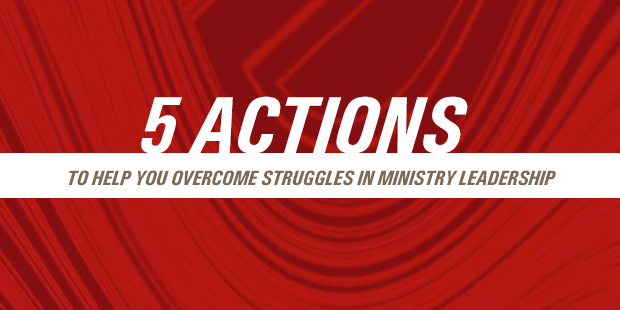
5 Actions to Help You Overcome Struggles in Ministry Leadership
Struggle is a part of any human endeavor and leadership is no different. The problem is we view struggle as a negative. But struggle is how we grow. Without them we can’t reach our full potential as leaders.
We like to think of our leaders as flawless. We like to be perceived as flawless—or at least we like people to think we have everything under control. But as Joe Badaracco has pointed out, “leadership is a struggle by flawed human beings to make some important human values real and effective in the world as it is.”
It may sound counterintuitive, but considering the benefits illuminated by Stephen Snyder in Leadership and the Art of Struggle, we should welcome it as an important element of the leadership process and our own personal development. Snyder writes that we should face struggle “head on—not hiding from it or feeling shame—because struggle is the gateway to learning and growth.” It can also help us to discover our purpose and meaning and develop the adaptive energy necessary to sustain our leadership for a lifetime.
Struggles have three defining characteristics:
Change: Every struggle is triggered by some type of change.
Tensions: Change creates a natural set of tensions.
Being out of Balance: Change and its ensuing tensions throw a leader off balance. This may happen without us even being aware of it, but acknowledgement of it is central to regaining control.
In the world we live in today, this is a common occurrence often leading to burnout unless we learn to see struggle through a different lens. Snyder recommends the following 5 actions to overcome those struggles:
- Adopt a growth mindset. The first step in accomplishing this is through reflection—being aware of what is going on around you. Snyder’s former colleague at Microsoft, Frank Gaudette, used to say: “I reserve the right to wake up smarter every day.” A good mantra to make our own.
- Center your mind, body and spirit. We all need some way to anchor ourselves and gain perspective that we practice daily like exercise and diet, prayer, connecting with nature, meditation, and/or journaling.
- Build your support community. “Create a community of people whom you can connect and bond with and from whom you can seek advice and feedback.”
- Overcome your blind spots. Blind spots by their very nature are hard to recognize. And they are frustrating because they blind us from seeing why people may be responding to us in counterproductive ways—leading us to finger pointing rather than personal responsibility. “Blind spots,” writes Snyder, “are the product of an overactive automatic mind and an underactive reflective mind.” A fairly common blind spot Snyder calls the Conflict Blind Spot. This blind spot can cause someone to interpret every interaction through a distorted lens. It reinforces the perception that the other person is wrong and we are right.
- Recommit, pivot, or leap. When we struggle we have essentially three options. The first is to recommit and stay the course. The second is to pivot and make a course correction. And third is to leap into uncharted territory far beyond our comfort zone. Choosing the right option requires that we examine ourselves and determine which choice is most consistent with our personal values or mission statement.
Every struggle is a chance to learn and to confront who we are and what we are becoming. Seen in that light, they are a gift. And our ability to deal with our own struggles effectively has an impact on those around us. Not only does it create a more positive environment to function in, but it provides a constructive example for others to follow.
Snyder has written an outstanding and practical book to help us to rethink the challenges and problems we face along the way. One of the best you’ll ever read on the topic.
Read more from Michael here.

Tags: Leadership Barriers, Leadership Engine, Michael McKinney, Personal Clarity











